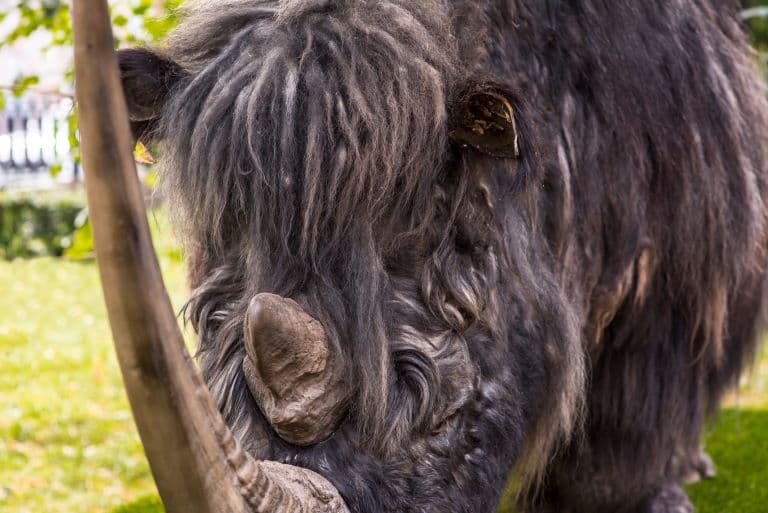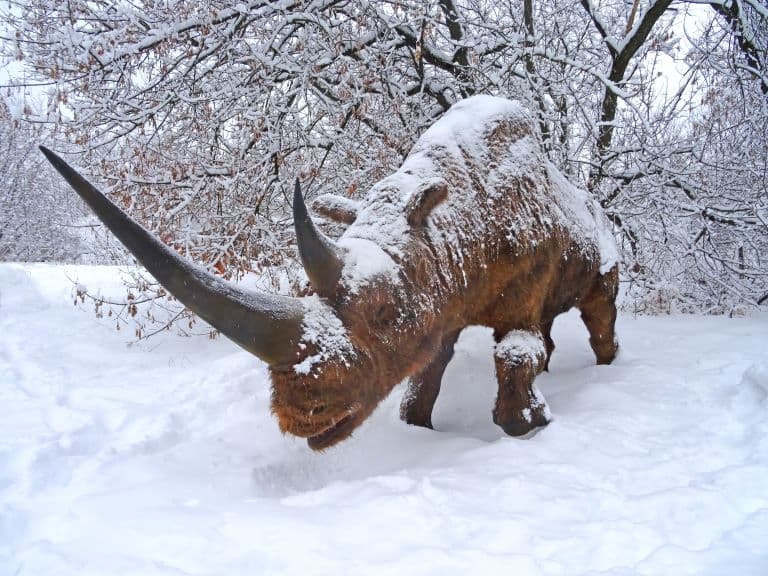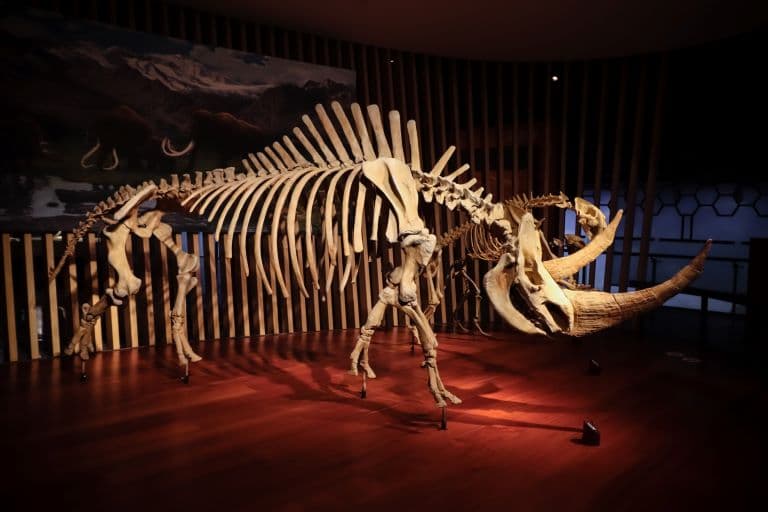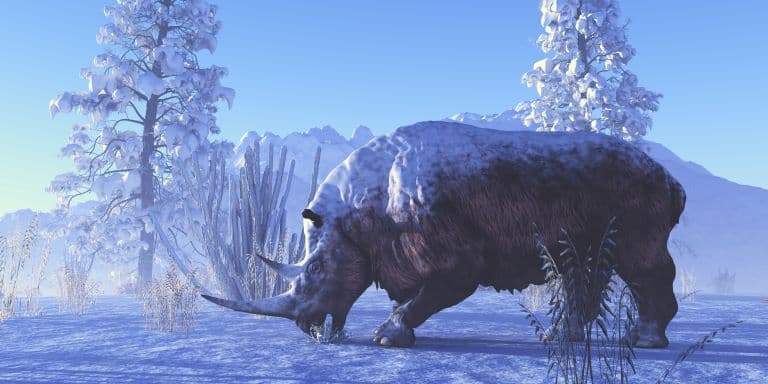Woolly Rhino Profile
Northern Europe wasn’t always a cluttered monoculture of agriculture and livestock grazing. It was once part of the largest biome on Earth: the mammoth steppe. And despite the cold, this a phenomenally productive zone, on which highly nutritious forbs and grasses would grow.
As such, it housed a diversity of large mammals as diverse as the African savanna. Where now there are vast fields of what, there were once vast herds of rhinos. And before agriculture was developed, they shared their space with our hunter-gatherer ancestors.
The Woolly rhino was a spectacular animal, covered in thick hair and sporting a horn as long as the people who saw it.

Woolly Rhino Facts Overview
| Habitat: | Steppe |
| Location: | Northern Eurasia |
| Lifespan: | Unknown |
| Size: | 3.6m (11.8ft) long |
| Weight: | Up to 2 tons |
| Colour: | Reddish-brown |
| Diet: | Grasses, cereals and forbs |
| Predators: | Hyenas, lions, humans |
| Top Speed: | Unknown |
| No. of Species: | 1 |
| Conservation Status: | Extinct |
It shared the land with other giants like the mammoths and the mastodons and lived well with humans for several thousands of years.
Early paintings celebrate its power and carvings were made out of its horn, but sometime around 14,000 years ago its numbers dropped off significantly, and not long after that it went extinct.
Interesting Woolly Rhino Facts
1. They had the hump
A short temper is a well-known characteristic of rhinos in general. They don’t have much in the way of eyesight, so they get by with a short fuse and a face full of weapons. But in at least this instance, the hump was a literal protrusion.
Much like other cold-weather heroes such as the bison or the mammoth, this rhino had a mass on the back of its neck. In some animals, humps store fat for the harsher seasons. In others, they’re a collection of muscles to generate immense power in the head – something which is good for pushing thick snow aside to find food.
Both of these would have been handy to have in the woolly rhino’s environment; this was a place where Winters would have been brutal, and most animals would have migrated to more habitable climes.

2. They were horny
One of the reasons this hump was even necessary was as a counterbalance for their colossal horn.
Woolly rhinos had two horns, the primary reaching lengths of around 1.4 meters (4.6ft) and the rear ranging from a small nub to around 50cm (1.5ft), both of which would have required significant musculature to carry around, let alone swing into their enemies.
The primary horn is somewhat flattened, which supports the idea that it was used as a snow shovel during heavy precipitation on the mammoth steppe.
These horns were so huge that they inspired legends. Early Siberian cultures talked of a giant bird whose claws were found in the frost. This bird ate boulders and large trees and had a battle with a sea monster, in which its talons broke off.
Raptor talons were a big part of Siberian shamanism, so finding a woolly rhino horn must have brought some incredible status to whoever was wielding it.
Spear throwers, as well as spears themselves, made from rhino horn have also been found in the far North of Russia, suggesting the horn had a multitude of uses for Siberian hunters too.
The horns are also so heavy that these rhinos have ossified sections of their nose cartilage to support it, something which is not found in any extant species. 1

3. They would have had epic battles
There appears to be a more significant difference in horn size between males and females than in extant species, which suggests that one of the primary uses for this horn was competition between males.
Cave paintings are a phenomenal record, passed down from modern humans living in a time when everything was different. These records even predate agriculture and are testaments to the effectiveness of human communication to pass on useful information even after tens of thousands of years.
Human art from around 30,000 years ago in a French cave encapsulates two of these huge beasts locked in eternal combat, a battle that can still be witnessed roughly 12,000 years after the species disappeared.
These paintings also depict rows of rhinos, their enormous horns staggered into the distance, perhaps as a way of depicting how numerous they once were in that part of Europe.
4. The last of the hole-tooths
And it’s amazing what we can garner from just a tooth. These teeth show wear patterns consistent with the forces generated by pulling grass out of the ground, and bones around the neck show that these rhinos had the corresponding neck muscles for this too, telling us that the woolly rhino was a grazer.
The unique nature of these teeth lent this species their scientific name, Coelodonta antiquitatis, roughly translating to hole-tooth of antiquity. 2
5. They might not have been very tasty
It’s rare to hear about a large herbivore that humans didn’t wipe out through over-hunting, but so far there’s little evidence that woolly rhinos were on the menu at all for stone-age humans.
Mammoths, giant sloths, and even colossal bears were part of the standard meat supply in the Palaeolithic period, as evidenced by tool scrapes and even bite marks on their bones. In the remains of the woolly rhinos, so far, this evidence is slim.
There are some signs of human weaponry in rhino bones and a few sites where it’s clear that their bone marrow had been extracted by humans, but compared with mammoths, they don’t seem to have been nearly as popular.
Even cave art depicts rhinos a lot less than some of the other, possibly tastier megafauna. This may have something to do with the areas in which rhinos and mammoths overlapped with humans.
While mammoths were common in Western and Central Europe, the rhinos may have been relatively safer further up North in the vastness of Siberia. 3

6. Climate change wiped them out
While we know that humans and woolly rhinos shared a habitat, current research suggests that the two species cohabited in relative harmony for at least 16,000 years. Rhino remains suggest a stable population until a sudden drop-off, around 14,000 years ago.
This period coincides with a rapid warming event, which heavily implies that the climate had a lot to do with it.
Previously firm permafrost would have turned to marshy bog. What was once a specialised snow shovel would have become a redundant, heavy ornament. Thick, shaggy fur that was so good at keeping the cold out now keeps the heat in, reducing movement.
Genetic assessments of the remains also suggest there was a stable population at the time, so with the rhino slowing down, human hunters could have perhaps had more of an interest in them as a food source.
Whether humans played a role or not, climate change turned a tundra specialist into a failed lineage in just a few centuries, and as we’re now experiencing warming on a scale not yet observed, this should act as yet another warning sign for the extinctions to come. 4
Woolly Rhino Fact-File Summary
Scientific Classification
| Kingdom: | Animalia |
| Phylum: | Chordata |
| Class: | Mammalia |
| Order: | Perissodactyla |
| Family: | Rhinocerotidae |
| Genus: | Coelodonta |
| Species: | Antiquitatis |
Fact Sources & References
- Mikael Fortelius (1983), “The Morphology and Paleobiological Significance of the Horns of Coelodonta antiquitatis (Mammalia: Rhinocerotidae)”, Journal of Vertebrate Paleontology.
- DANIELLE SCHREVE (Year), “A Middle Devensian woolly rhinoceros (Coelodonta antiquitatis) from Whitemoor Haye Quarry, Staffordshire (UK): palaeoenvironmental context and significance”, JOURNAL OF QUATERNARY SCIENCE.
- YAROSLAV V. KUZMIN (2010), “Extinction of the woolly mammoth (Mammuthus primigenius) and woolly rhinoceros (Coelodonta antiquitatis) in Eurasia: Review of chronological and environmental issues”, Sci Hub.
- Alex Fox (2020), “Climate Change, Not Hunting, May Have Doomed the Woolly Rhinoceros”, Smithsonian Magazine.
